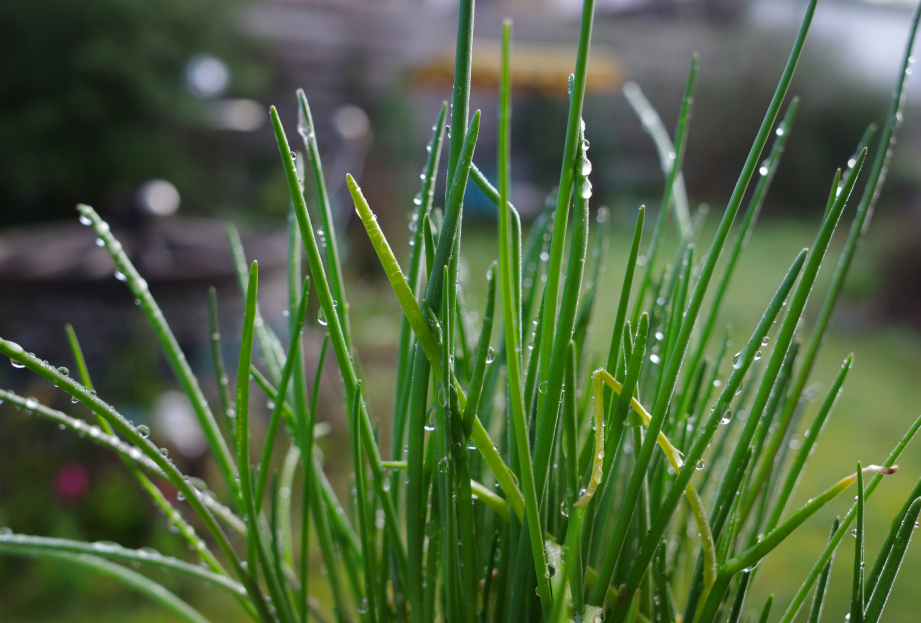
Chives are a perennial herb from the onion family, known for their mild onion flavor and attractive grass-like appearance. They’re easy to grow, making them a popular choice for herb gardens and container growing. Whether used to garnish dishes or added to salads, soups, and more, they are a versatile and low-maintenance herb. Here’s a guide on how to grow and care for chives.
8-12” Spacing • 12-18” Height • Perennial • Full sun/Partial Shade • Hardiness Zones 3-11
Chives thrive in full sun, needing about 6-8 hours of direct sunlight daily. They can tolerate partial shade, but for optimal growth and flavor, they should be grown in a sunny spot. Indoors, place them near a bright, sunny window, preferably south-facing, or use grow lights to supplement natural sunlight.
Chives are relatively light feeders but will benefit from occasional fertilization. Use a balanced, all-purpose fertilizer once or twice during the growing season, typically in the spring and summer. If grown in containers, you can apply a diluted liquid fertilizer every 4-6 weeks. Avoid over-fertilizing, as this can lead to excessive leaf growth at the expense of flavour.
Chives prefer evenly moist soil but are quite tolerant of drought once established. Water them when the top inch of soil feels dry, usually once a week. Ensure the soil drains well, as they do not like to sit in waterlogged soil, which can cause root rot. Consistent, moderate watering is key to healthy, flavorful plants.
Chives thrive in well-draining, fertile soil with a pH of 6.0-7.0. A good-quality potting mix will work well for container-grown varieties. They can be left in the same spot for several years without needing to be re-potted, but if growing in containers, you might want to re-pot every 2-3 years to refresh the soil and give the roots more room to grow. Choose pots with proper drainage holes to prevent water accumulation.
Chives are hardy in USDA zones 3-9 and can tolerate a wide range of temperatures. They prefer temperatures between 60°F and 85°F (15°C to 29°C). They are frost-tolerant and will survive cold winters in many regions, dying back in the winter and regrowing in the spring.
Chives can grow in a wide range of humidity levels, though they prefer moderate humidity. They thrive in typical indoor or outdoor environments. Good airflow around the plants is important, especially in more humid conditions, to prevent fungal diseases.
Chives can be propagated from seeds, division, or cuttings. Seeds are usually sown directly into the soil in the spring. However, they are most commonly propagated by division, which involves separating clumps of them and replanting them in new areas. This method is best done every 2-3 years to keep the plants healthy and productive.
Regular harvesting is the best form of pruning for chives. Snip off leaves from the base of the plant as needed, but avoid cutting more than one-third of the plant at once to allow for regrowth. In late summer or early fall, trim the entire plant back to about 2 inches above the soil to encourage fresh growth. Deadheading (removing spent flowers) is recommended to prevent the plant from self-seeding and becoming invasive.
Chives are relatively pest-resistant, but they can occasionally be affected by aphids or thrips. These can be managed by spraying the plant with water or using organic insecticidal soap. Fungal diseases like downy mildew or leaf rot may occur in overly wet or humid conditions, so ensure good airflow and avoid overwatering. Root rot can be an issue if the soil doesn’t drain well.
No, chives are toxic to cats and dogs. While small amounts may not cause immediate harm, ingestion of larger quantities can lead to gastrointestinal upset and potentially more severe symptoms like anemia. Keeping them out of reach of pets is best to prevent any accidental consumption.
Chives thrive in full sun, needing 6-8 hours of direct sunlight per day.
Water when the top inch of soil feels dry, typically once a week, but ensure the soil drains well.
Chives grow best in well-draining, fertile soil with a pH of 6.0-7.0.
Yes, chives can be grown indoors, provided they receive plenty of sunlight or are supplemented with grow lights.
Chives can be propagated by seeds or division. Division is the most common and effective method.
Chives thrive in temperatures between 60°F and 85°F (15°C to 29°C) and are hardy in USDA zones 3-9.
Harvest chives regularly by cutting leaves from the base, and trim the entire plant in late summer or fall to encourage new growth.
Chives can occasionally be affected by aphids or thrips. Fungal diseases can occur in overly wet or humid conditions.
Chives benefit from occasional feeding with a balanced fertilizer, especially if grown in containers.
No, chives are toxic to cats and dogs and should be kept out of their reach.